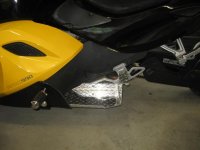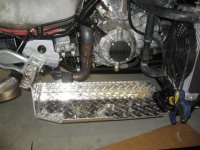Dick Wells
New member
At some point in time, I'll have pics on what I've done, but for now, just let me descrbe what I've done, up to this point. You'll see the start of this little discussion in another thread in this forum.
I had found the RS riding position to be un-livable for my 71 year-old bones.
I knew that I probably wanted diamond plate aluminum for the boards, and, since I had some 1/16 polished DP kicking around, I bought some nice 1/2 in. sanded plywood, and about 8 ft. of 1/2 X 1.5 in. heavy C-channel. Got some 3/4 outside aluminum C-channel to hide the edges, and proceeded to start cutting and fitting. Put two longitudinal skids, running from the flat sub-frame under the oil tank, back to about 4.5 in. below the rider's peg bosses. These being about 5 in. apart, and parallel, and allowing a board of about ~ 8 in. in width, and ~22 in. long. There is a little kick-up, of about 10 degrees, about 14 in. from the front edge, to put that front portion over the sub-frame. With the components of the board screwed together with all SS fasteners, and a perforated 1/16 thick steel bracket, suspended from a tubuar steel peg, mounted where the rider's peg used to be, and the C-channel (or "U" shaped) aluminum edging, hiding the diamond-plate/plywood edge, it's not looking all that bad.
This whole concept requires some mods, to make things work with a Spyder, starting, early-on, with re-locating the oil tank (for foot/boot clearance) about 1.5 inches outward, and forming a new bottom bracket for it, to take the rubber pads that it sits on. Took a little moding of the upper bracket, too. I had to run a new oil line (copper tubing/ W-original rubber oil line at each end), down and under the board, but above C-channel skids/frame, which has a little wide, shallow "U" cut, bent and welded, for clearance of that line. BTW, the steel C-channel is used flat side up, ribs down, and the 1.5 in flat sides are all drilled full of 1/2 in staggered holes for an attempt at keeping weight down. None of this stuff sticks down lower than the rest of the bikes center frame. BTW, I estimate that I've added no more than about 16 lbs to the bike, so far.
The shifter got cut off, right behind the peg, and I used 1/4 X 1.5 in steel strap and lengthened the thing 2" (the first time), and reversed it, which of course, reverses the shift pattern. I drilled holes through the plate, after it was smoothed and polished, starting at the (now) rear, with about a 1" hole, and moving on down the taper to near the peg, with about 1/2". Looked good, and worked so good that I chopped it off again, and put in another 1 and 3/4", and a couple more holes. Re-polished and it's now painted nice shiny black, and it shifts like a dream. Neutral is super easy to find, with all that throw, way out there on the end!
The right side is sort of a mirror image of the left, and the brake pedal is a DIY, with a NAPA rubber pad, and it's mounted about 14" forward of the original and about 3" lower. There's a turn-buckle for adjustment between the new pedal and the old, which has a lever added to the inside, with a little dog-leg, which allows for leverage, working with the front pedal. I didn't have to modify the original pedal at all, just welded up a steel dog-leg to extend forward and a little upward, some 30-odd degrees. It's molded right around the front end of the old pedal, and bolted through without cutting, welding or drilling the original in any way. Didn't want any liability issues with any insurance company, if anything ever happened to me, or the bike. The original pedal is still usable, as it was before.
Most of the Tupper-Ware is still off the bike. I have to cut out the inside of the side covers to make room for my shins, and form some new fiberglass air shrouds and baffles to direct hot air out and away, like it used to. Riding, right now, is more than a little warm on the feet, ankles and shins! Strangest thing, though, riding in the rain, or, actually, in any conditions, doesn't seem to have changed the flow of air around the rest of your body. IE, it's very much like before; The Spyder is pretty remarkable, in that you can stay pretty dry and warm, from say, under your shoulders on down, even in pretty cold, wet conditions. Go figure.
I'll have to try to get checked out on posting pictures, so that this rambling will (perhaps) mean something. Meanwhile, I have to say that having my #11's up forward about 18 inches is a welcome relief, indeed. Now, I need to work on getting some more boards designed and built for my poor wife of 50 years, so that she isn't all scrunched up back there. Oh, and some hand-rails that come up far enough, so that she doesn't have to slouch to hang on!
Another OH! I do have 4.5" risers and mirror extensions.
 opcorn:Shoot, I just tried to edit my omission in floo-boards in the heading, and I can't. Wonder how many more flubs I have in this post?
opcorn:Shoot, I just tried to edit my omission in floo-boards in the heading, and I can't. Wonder how many more flubs I have in this post?
Are you bored yet?:spyder:
I had found the RS riding position to be un-livable for my 71 year-old bones.
I knew that I probably wanted diamond plate aluminum for the boards, and, since I had some 1/16 polished DP kicking around, I bought some nice 1/2 in. sanded plywood, and about 8 ft. of 1/2 X 1.5 in. heavy C-channel. Got some 3/4 outside aluminum C-channel to hide the edges, and proceeded to start cutting and fitting. Put two longitudinal skids, running from the flat sub-frame under the oil tank, back to about 4.5 in. below the rider's peg bosses. These being about 5 in. apart, and parallel, and allowing a board of about ~ 8 in. in width, and ~22 in. long. There is a little kick-up, of about 10 degrees, about 14 in. from the front edge, to put that front portion over the sub-frame. With the components of the board screwed together with all SS fasteners, and a perforated 1/16 thick steel bracket, suspended from a tubuar steel peg, mounted where the rider's peg used to be, and the C-channel (or "U" shaped) aluminum edging, hiding the diamond-plate/plywood edge, it's not looking all that bad.
This whole concept requires some mods, to make things work with a Spyder, starting, early-on, with re-locating the oil tank (for foot/boot clearance) about 1.5 inches outward, and forming a new bottom bracket for it, to take the rubber pads that it sits on. Took a little moding of the upper bracket, too. I had to run a new oil line (copper tubing/ W-original rubber oil line at each end), down and under the board, but above C-channel skids/frame, which has a little wide, shallow "U" cut, bent and welded, for clearance of that line. BTW, the steel C-channel is used flat side up, ribs down, and the 1.5 in flat sides are all drilled full of 1/2 in staggered holes for an attempt at keeping weight down. None of this stuff sticks down lower than the rest of the bikes center frame. BTW, I estimate that I've added no more than about 16 lbs to the bike, so far.
The shifter got cut off, right behind the peg, and I used 1/4 X 1.5 in steel strap and lengthened the thing 2" (the first time), and reversed it, which of course, reverses the shift pattern. I drilled holes through the plate, after it was smoothed and polished, starting at the (now) rear, with about a 1" hole, and moving on down the taper to near the peg, with about 1/2". Looked good, and worked so good that I chopped it off again, and put in another 1 and 3/4", and a couple more holes. Re-polished and it's now painted nice shiny black, and it shifts like a dream. Neutral is super easy to find, with all that throw, way out there on the end!
The right side is sort of a mirror image of the left, and the brake pedal is a DIY, with a NAPA rubber pad, and it's mounted about 14" forward of the original and about 3" lower. There's a turn-buckle for adjustment between the new pedal and the old, which has a lever added to the inside, with a little dog-leg, which allows for leverage, working with the front pedal. I didn't have to modify the original pedal at all, just welded up a steel dog-leg to extend forward and a little upward, some 30-odd degrees. It's molded right around the front end of the old pedal, and bolted through without cutting, welding or drilling the original in any way. Didn't want any liability issues with any insurance company, if anything ever happened to me, or the bike. The original pedal is still usable, as it was before.
Most of the Tupper-Ware is still off the bike. I have to cut out the inside of the side covers to make room for my shins, and form some new fiberglass air shrouds and baffles to direct hot air out and away, like it used to. Riding, right now, is more than a little warm on the feet, ankles and shins! Strangest thing, though, riding in the rain, or, actually, in any conditions, doesn't seem to have changed the flow of air around the rest of your body. IE, it's very much like before; The Spyder is pretty remarkable, in that you can stay pretty dry and warm, from say, under your shoulders on down, even in pretty cold, wet conditions. Go figure.
I'll have to try to get checked out on posting pictures, so that this rambling will (perhaps) mean something. Meanwhile, I have to say that having my #11's up forward about 18 inches is a welcome relief, indeed. Now, I need to work on getting some more boards designed and built for my poor wife of 50 years, so that she isn't all scrunched up back there. Oh, and some hand-rails that come up far enough, so that she doesn't have to slouch to hang on!
Another OH! I do have 4.5" risers and mirror extensions.
Are you bored yet?:spyder:
Last edited:


